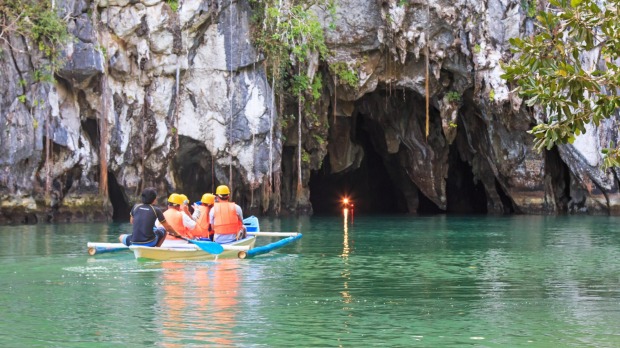
I am just about to bite into a worm, an extremely long worm. As a child I had occasionally thought of eating a dirt-encrusted juicy one from the garden but had thought better of it.
But this time there is no escape. I have actually ordered it from the worm vendor who has set up his stall outside the restaurant where I am having a fine buffet lunch after returning from a trip down one of the the New 7 Wonders of Nature and a refreshing driftwood worm seems to be in order.
The Puerto Princesa Underground River in the Palawan islands in the Philippines is a UNESCO World Heritage Site which is listed as as a place of outstanding universal value to humankind, and as I was being paddled further into the extraordinary subterranean waterway I could see why.
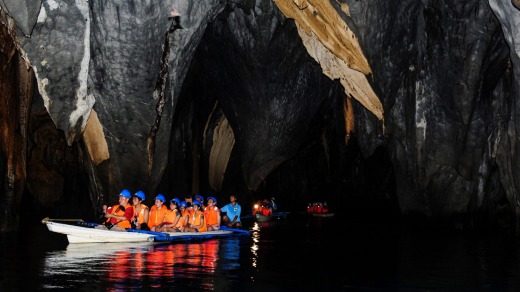
The subterranean river is a two-hour drive north from the Palawan capital of Puerto Princesa near the seaside village of Sabang. It winds its way more than eight kilometres under St Paul Mountain through a surreal cluster of caves dripping with surreal limestone formations – stalactites and stalagmites – that seem to have been sculpted to resemble the sort of strange, nightmarish creatures that could suddenly reach down and suck you into the upper reaches of the dark unknown.
And possibly, just possibly, the reason why no one can find the Loch Ness monster in Loch Ness is because he's moved here from Scotland for the warmer waters.
The underground river is a popular tourist site, not just for foreigners but also for Filipinos. A short boat ride from the busy jetty in Sabang takes you to the site, where after about an hour's wait spent engaging with the local monkeys, about eight to 10 passengers are assigned to kayaks that are then paddled through the mouth of the cave and into the darkness and the reverberating echoes.
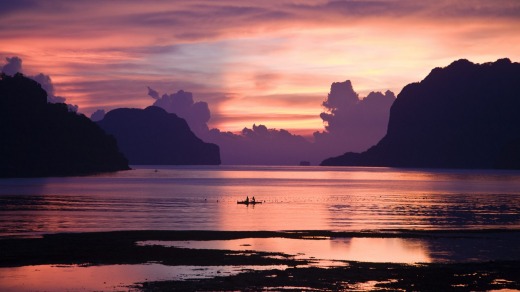
The local guide takes the boat into the first 1.5 kilometres of the cave and provides a running commentary about its many features and those of the river while one passenger is charged with shining a large torch at specified locations along the way. The guide takes great pleasure in pointing out that one such formation bears a striking resemblance to Sharon Stone. Filipinos appear to enjoy a good pun more than most people.
He also happily mentions that there are 80,000 bats in the cave (there are nine species) which illuminated by torchlight can be eerily disconcerting. There's no doubt that you want to stay on their good side.
While you head further into the cave, keeping keep one eye on the bats and the other on the swifts that swoop around you with little regard for your personal space, you reach a point known as the cathedral which is 65 metres high. It is nothing short of majestic. You could easily see the Pope in there taking a few damp confessions and conducting Mass.
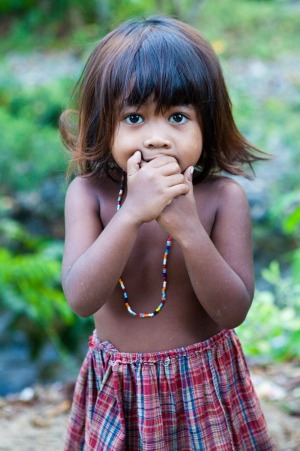
The underground river and cave is part of the Puerto Princesa Subterranean River National Park, a protected area which is thickly forested. Indeed, the whole of Palawan, which is composed of more than 1000 islands, has 70 per cent forest cover, nearly 50 per cent of which is old growth.
The forest is a highlight of any visit to Palawan and no more so during a walk through it to the tribal village of the Batak people, thought to be the oldest inhabitants of the Philippines, and one of three main tribes living near Puerto Princesa. Their numbers continue to dwindle.
The Batak village is about one hour from the main road that leads from San Rafael, where our hotel, the Astoria Palawan is located. Most of the 45 families ( there are about five people per family) in this village used to live higher up the mountain – about four hours from the road – but an outbreak of measles in which 15 children died convinced the village chief that they needed to be closer to medical services.

The tribe was traditionally nomadic and its people hunter-gatherers but they have now settled in one place. They generally live in thatch houses, sometimes raised from the ground on stilts. The villagers live on root crops, wild pig, rice and coconuts. They harvest rattan, tree resins and honey to sell. Projects are under way to teach them how to grow a wider variety of vegetables. If numbers are any indication they appear to be inordinately fond of dogs.
The children used to walk the one hour to school every day but quickly became homesick so a school was built in the village. It's still a work in progress but it fulfils its purpose in a community where any form of education was not easy to access.
Only a few years ago the Batak women preferred to be topless and the men got about clad only in a couple of strategically placed bits of string and bark, but more visitors from the outside meant that shorts and T-shirts were generally more appropriate for public appearances.
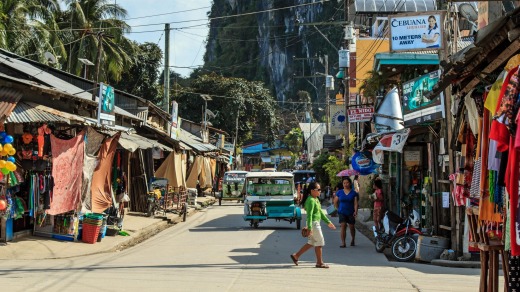
I am on my way up the hill with the other members of my Intrepid group to have lunch with the village chief and whoever else wants to join in. We – well, our porters – carry the food in and will bring any rubbish back with us.
It's an easy walk along a gentle incline of stony track and through several shallow streams. The forest is luscious and a light wind rustles through the coconut palms and cashew nut trees. The only disconcerting element in what is a delightful walk is the presence nearby of a native skunk, which although unseen makes its presence felt with an odour that attacks the senses and gives them a good kicking.
When we arrive at the village most people are attending the Sunday service at the Sweet Rain Church. Filipinos, even indigenous ones, are intensely religious. More than 80 per cent are Catholic and the remainder have mostly been converted to other Christian denominations.
As well as a church, the village has a full-sized outdoor basketball court. Filipinos are fanatical about the sport, even though they are generally not particularly tall. But what they lack in height they make up for in enthusiasm.
Lunch is a simple affair in the chief's hut: rice, vegetables, and chicken adobo, a popular local food that involves the meat being marinated in vinegar, soy sauce and garlic. It's the national dish of the Philippines.
I can't say I had ever given any thought to Filipino cuisine (how many Filipino restaurants are in your neighbourhood?) but it's surprisingly good and involves lots of different spices, meats, and seafood, including crocodile. Vegans would not exactly thrive here.
The Filipinos themselves are enthusiastic eaters and seem to have made time to squeeze in a couple of extra meals in a day.
Their other great obsession is spending time with family – even distant cousins are welcomed into family celebrations. Filipinos are invariably gregarious, warm and friendly, or as local writer Alfredo Roces writes:
"Filipinos, it has been said, are Malay in family, Spanish in love, Chinese in business and American in ambition."
Roces could also have added that they love to burst into song, often in the ubiquitous local karaoke bars. Perhaps this explains why what seems like every major hotel across Asia has a Filipino cover band.
After lunch with the chief, and the many other villagers who are invited to join us, we head back down the mountain and back to our hotel for several San Miguel beers and – your guessed it – some karaoke.
It's a six-hour drive to El Nido from San Rafael. The rice fields are dry and local farmers are waiting for the first drop of rain before planting can begin. Coconut palms and banana trees dominate the landscape and bougainvillea of scarlet, red and pink lines the sides of the road like gaily coloured sentries. Buffalo munch away quietly or languish in small muddy pools to escape the searing heat and humidity.
El Nido may sound like some climate-changing weather pattern but it's a medium-sized beachside town at the northern tip of Palawan. It's the gateway to the Bacuit Archipelago, a world of towering limestone cliffs, spectacular gorges, white sandy beaches and crystalline, coral-filled waters that are ideal for diving and snorkelling.
It's at El Nido that I notice the first real presence of foreign tourists, particularly the French, who are here for the upmarket resorts, boat trips and diving. Some have become stayed and become part of the business community. The centre of town is composed of attractive narrow streets that are busy with cafe's and dive shops that look over the sea. Mountains recline on the horizon. People talk of El Nido as being about to "take off".
Certainly, it does take off at night along the beachfront where restaurants and cafe's offer dining on the sand with the occasional live band providing the musical accompaniment.
On our first morning we embark on all-day trip snorkelling in coral reefs and lying on secluded beaches. The sea is sparkling in the shimmering light. Our three boatmen, Miguel, Romeo and Derek, hand out snorkels and masks and steer us out to sea and towards the coves formed by the vertiginous limestone outcrops that erupted out of the seabed many millennia ago.
The coves are eerily quiet. Its like being given permission to enter another world. The water is bath-warm and clear and so shallow in some points that the boatmen have to get out and push it across the seabed.
Out of the coves we take to the sea to swim and snorkel. There is no need for wetsuits here. It is almost as warm in the water as out. Brightly coloured fish of varying sizes dart around sea and hide in the dark corners of the coral beds.
The boat docks and we wade ashore to a secluded beach. We paddle in the shallows while our boatmen prepare a lunch of barbecue pork, freshly caught fish and squid followed by sliced mango and watermelon. It's hard to stay awake after that and several of us nod off in the cool of the shade.
As we head back to our resort at El Nido Cove, a pod of dolphins decides to escort us to the beach, like exuberant, playful guards, ensuring we get home safely before the sun slips below the ruby horizon.
Wading ashore, after such as sun-kissed adventure of a day, I am looking forward to a cold beer and dinner, although a quick look at the menu reveals there are no driftwood worms on offer. So it is fortunate that I ate the one I bought at Sabang. Soaked in vinegar and garlic, it was almost translucent. I was tempted to let it just slide down my throat in one long, slow, slithering swallow, but I decided instead to chew it slowly and with purpose. It doesn't taste like chicken.
MORE INFORMATION: tourismphilippines.com.au
GETTING THERE: Qantas flies direct from Sydney to Manila four days a week. Philippine Airlines has direct flights from Melbourne to Manila three days a week. Qantas via Sydney is the next best option. From Sydney, you can fly also direct to Manila with either Philippine Airlines or Cebu Pacific.
TOURING THERE
Philippines Island Getaway: departures from November to May – the main season for Palawan with good weather – from $1570 per person for an eight-day trip.
See intrepidtravel.com